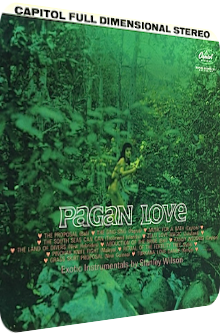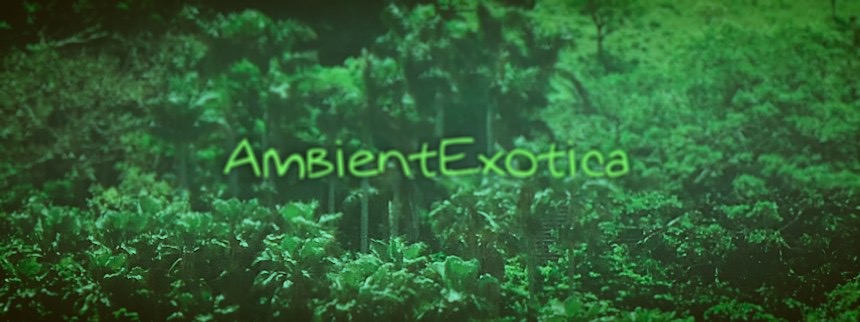
Stanley Wilson
Pagan Love
1961
Such a pity! Pagan Love, the Jungle Exotica work of trumpeter, conductor and film musician Stanley Wilson (1917–1970), is his only entry in this genre. Even though he was part of Juan García Esquivel's big band and worked together with Henry Mancini, Wilson was way too busy to waste his precious time with the creation of Exotica cuts. However, he at least delivered one album after being approached by Capitol Records.
In 1961, Pagan Love is finally finished and presents a very large scope on all of its twelve unique and never heard before inclusions. Not only does Wilson conduct a large string and brass ensemble, he also adds a mixed choir to most sceneries in order to expand the tribalism and ritualistic feeling of the composition. Exotic percussion, alto flutes and various mallet instruments round off the orchestral arrangements. Ten different jungles are (re-)visited in twelve tracks, and while most of the offered material thematizes love, devotion and obsession of native tribes, this isn't your typical romantic, cliché-driven album, despite the occasional fusion of such stylistic particles.
Most of the time, Pagan Love takes the listener on an adventurous journey, and it is never clear what to expect, as quiet passages are exchanged by rapid-firing intersections all the time. It's a vivid album that sounds marvelous and fresh even by today's standards. One could even count it to the travelog craze that is so common in the Exotica genre. However, I've decided against this categorization, for the listener doesn't aurally travel from one destination to another, but remains in jungle territories all the time. Pagan Love is a worthwhile addition to any Exotica collector's treasure box. In short: title and front artwork live up to the hype they create in tandem. A more detailed description follows below.
And away the listener goes to the jungle thickets of Bali where The Proposal (Bali) takes place right this instance. The first thing that can be heard are four intimidatingly droning brass eruptions, followed by much more vivid xylophone sprinkles and flute melodies. Gentle violins and liquid harp strings waft in the background, making a soothing fanfare out of the formerly threatening intro. A low-volume mixed choir is humming in the background while a varying four-note horn and violin motif further silkens the orchestral panorama of this emerald-green jungle. The Proposal is nonetheless a lackluster launch of Pagan Love, for it becomes too saccharine after the huge opening section, and although the glinting harps are very welcome, the melodies don't exactly evoke a jungle Exotica theme.
All is forgiven in the following composition, The Sing-Sing (Papua), and since there are still living cannibals in Papua New Guinea to this day, the dangerous excitement is poignantly delivered by a droning bongo introduction, a thirteen-note melody sung by the effervescent mixed choir that is accompanied by a paradisiac flute, and tremendously punchy brass eruptions. Despite their attack rate and darker colors, they aren't all too threatening in this rather blithesome and uplifting setting, but this changes in the middle section with boldly hammering brass sections and ooh! chants. The permanent oscillation between a wild savage ritual and the majesty of an ancient jungle is successfully created, making this the first obvious hit of the album, and it won't be the last…
… as Music For A Bath (Ceylon) promises the soothing phantasmagoria of its auspicious title to the point. This ballad comprises of a cozy concoction of alto flutes, a stream of gentle orchestra strings and colorful harp splashes. Droning double bass accents only expand the mystique and tranquilizing beauty of an intimate glimpse at the titular bathing site. Careful tambourins and timpani add the slightest scents of movement and excitement, as does the main melody which is played on a trombone in the second half of the arrangement. Regardless of the used instruments, the balmy mood remains. A huge hit.
The following The South Seas Can-Can (Trobriand Islands) starts with droning drums, hollow bongos, a double bass melody and echoing flutes plus horns. The incisive darkness of the brass main melody is soon replaced by a military parade-like setting with an expectedly catchy melody. It's definitely one of the weaker tracks, and only the omnipresent golden thread of the bongos prevent this ditty from being a a total dud. Military marches and Exotica don't mesh well together, not even when Arthur Lyman is on the vibes, which he isn't on this album anyway. While the delicious Zulu Love Magic (Zululand) injects the first dose of mystique thanks to its warped flute, the shady tonalities of the backing horns and a humming choir as well as many quieter passages of warmer sunset-colored regions, the final track of side A, The Land Divers (New Hebrides), opens with the very best percussive section, consisting of congas, bongos, djembes and a savage choir singing in pidgin to the tribal erection which is later rounded off with thundering staccato horns and trembling violins. It's a huge composition with a large scope, and since the first minute is based on anything else than exotic percussion and a wild choir, it lives up to both the front artwork and the title. A huge, totally satisfying listening experience!
Side B delivers material in the vein of side A, Wilson never loses the qualitative aspects out of his sight. Abduction Of The Bride (Bali) takes the listener to an adventurous journey in Bali for the second time, merging convivial flute melodies with rhythmical staccato drums and horns, with an eminently gleaming trumpet main melody that inherits the conductor's work for films and TV shows. It's utterly catchy and purposefully over the top, carrying the whole arrangement. The final section is gentler, implying the rescue of the bride who falls into the arms of her hero as the glistening vibraphones and syrupy Hollywood strings put the finishing touches to this adventure.
Kandy Wedding (Ceylon) is the second Ceylon-related composition and a romantic Exotica ballad if there ever was one, with an alto flute main melody, carefully beaten congas, rose-tinted strings and wafting acoustic guitar accentuations. I have to admit that I'm quite fond of this little interlude, even though it's all too mild-mannered. Pinchak Knife Fight (Malaya), on the other hand, crashes into the dreamy aura with a scattering brass burst, furious timpani, cacophonous and tense horn sections with short harp injections and xylophone glitters. It's a cinematic piece that closes with a mourning phase of dusky violins and doleful harps.
While Ritual Of The Fertility Tree (India) shuttles once more between a baneful aura of mystique and melodrama thanks to its rattling shakers, mixed choir-accompanied nocturnal strings and droning trumpet tones, Grass Skirt Proposal (New Guinea) paints a romantic paradise with dulcet flutes, cascading harps, the humming mixed choir and polished Hollywood strings, with not one dangerous threat in sight. The album closes with Turkana Love Dance (Kenya), a superb ritual with many hand claps, fulminant drums, Latin trumpet melodies and staccato strings. The chants of the mixed choir boost the tribal aspect, but the last 40 seconds take the crown, as a shift in rhythm features loud screams of the same choir, enigmatic percussion and rapid-firing brass stabs, thus ending the album with a titular Pagan ritual.
Stanley Wilson's only Exotica entry remains a gem if you're fond of the orchestral dimensions of the otherwise intimate genre. While there are quieter passages that build formidable counterparts to the thunderous phases, the scope of the production and the depicted incidents are undoubtedly large, at times even gargantuan. The strong focus on exotic percussion, the flute melodies and especially the horn eruptions make this a ritualistic, savage record that presents a tour de force through several jungles all around the world. Each and every composition is unique, very cinematic and shows the craftsmanship of Wilson's background as a film scorer.
Highlights include the attacking trumpets on The Sing-Sing (Papua), the utterly dreamy Music For A Bath (Ceylon) as well as the eclectic percussive patterns on The Land Divers (New Hebrides). If there is one real dud, it is either the sugar-sweet album opener The Proposal (Bali) that is far too boring and harmless in comparison to the remaining eleven tracks, or The South Seas Can-Can (Trobriand Islands) with its military march structure. Apart from these forgivable misses, the album shines and is one of the most cinematic Exotica gems you can possibly get. It is never clear what is to be expected; quieter passages follow after baneful thunderstorms, and vivacious xylophone spirals lessen even the harshest brazen passage. The music lives up to the hype which is suggested by the title Pagan Love.
The merger of romance with adventurous jungle outskirts is perfectly accomplished by Stanley Wilson, and it is a true pity that he didn't deliver a follow-up of some sorts to this huge album. If you crave for a similar album, take Dominic Frontiere's Pagan Festival (1959) into account; believe me, I do not suggest Frontiere's album due to the title-related parallelism, but solely because of its orchestral resemblance, for it features a choir on dreamy and pompous arrangements as well. Stanley Wilson's Pagan Love is unfortunately unavailable on digital music stores, even though it was released on the prestigious Capitol Records. This will change sooner rather than later, I hope, for this emerald-green artifact is not to be missed.
Exotica Review 121: Stanley Wilson – Pagan Love (1961). Originally published on Sep. 15, 2012 at AmbientExotica.com.
